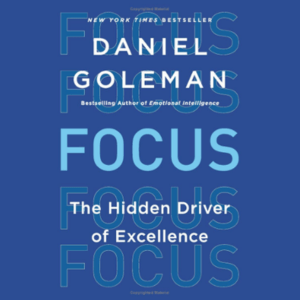Focus: the hidden driver of excellence – Unveiling the Power of Concentration

In a world overflowing with distractions, our ability to focus has become the ultimate superpower. Daniel Goleman, the renowned psychologist and author of the groundbreaking “Emotional Intelligence,” tackles this critical skill in his book “Focus: The Hidden Driver of Excellence.” This blog delves into the core concepts of the book, offering a comprehensive review and summary to guide you on your journey to mastering your attention.
About the Author – Daniel Goleman
Daniel Goleman is an American psychologist, author, and science journalist. During his academic journey, Goleman spent time in India. He received a pre-doctoral fellowship from Harvard and a post-doctoral grant from the Social Science Research Council. While in India, he connected with the spiritual teacher Neem Karoli Baba. Goleman’s experiences in India inspired his first book, based on travel in India and Sri Lanka.
Goleman’s most famous work is the 1995 book “Emotional Intelligence”, which remained on The New York Times Best Seller list for a year and a half. Apart from emotional intelligence, he has written extensively on topics such as self-deception, creativity, transparency, meditation, social and emotional learning, ecoliteracy, and the Dalai Lama’s vision for the future.

Book Summary – Focus: The Hidden Driver of Excellence
Part 1: The Anatomy of Attention
Goleman introduces the concept of attention as a fundamental mental asset. He likens attention to a muscle: when used poorly, it withers; when exercised well, it grows. Understanding the different types of focus—inner, other, and outer—is crucial for navigating life effectively.
The book opens by highlighting the three pillars of attention: internal, external, and other-oriented.
- Internal Attention: This refers to our awareness of our own thoughts, emotions, and bodily sensations. It’s the foundation for self-regulation and effective decision-making.
- External Attention: This encompasses our ability to direct our focus on the external world, such as tasks, objects, or sounds.
- Other-Oriented Attention: This involves our capacity to pay close attention to others, their emotions, and nonverbal cues. It’s crucial for empathy and building strong relationships.
Goleman emphasizes that these types of attention are not mutually exclusive. High achievers possess the agility to shift seamlessly between them depending on the situation.
Part 2: Self-Awareness
Goleman emphasizes the importance of self-awareness in enhancing focus. He explores the concept of “automatic attention,” the autopilot mode where our minds wander unconsciously. Mindfulness meditation emerges as a powerful tool to cultivate self-awareness and counter automatic attention. By becoming aware of our thought patterns and emotional triggers, we can choose how to respond rather than react impulsively.
Part 3: Reading Others
This part explores how we direct our attention outward—toward understanding and empathizing with others. Other-oriented attention is vital for building strong relationships and navigating social situations effectively. Goleman delves into the science of emotional intelligence (EQ) and how it influences our ability to “read” others. He explains the importance of nonverbal cues, empathy, and active listening in fostering meaningful connections.
Part 4: The Bigger Context
Focus isn’t just about individual attention; it also involves understanding the broader environment that shapes our choices. Goleman discusses the impact of technology, workplace dynamics, and cultural norms on our ability to focus. He emphasizes the need to create environments that promote sustained attention and minimize distractions.
Part 5: Smart Practice
Goleman introduces the concept of “smart practice” – deliberate strategies to enhance and maintain focus. This includes techniques like:
- Goal Setting: Setting clear, achievable goals helps direct our attention and provides motivation.
- Focused Breaks: Short breaks focusing on activities like deep breathing can refresh attention and improve performance.
- Positive Reinforcement: Recognizing and rewarding focused behavior strengthens the focus muscle.
Part 6: The Well-Focused Leader
Leadership demands exceptional focus. Goleman illustrates how effective leaders balance inner, other, and outer focus. They prioritize what matters most while considering the needs of their team and the organization. Goleman outlines the characteristics of well-focused leaders who:
- Practice self-awareness and emotional intelligence.
- Clearly define your goals and effectively communicate it.
- Foster a culture of focus within their teams.
- Delegate tasks strategically.
Part 7: The Big Picture
The book concludes by highlighting the importance of focus for a fulfilling life. By mastering our attention, we can achieve greater productivity, build stronger relationships, and navigate the complexities of our modern world. Goleman emphasizes that focus isn’t just about achieving more; it’s about living a more present and enriching life.
In the final part, Goleman calls upon readers to broaden their attention beyond personal concerns. We must turn our focus toward pressing global problems, the powerless, and the future.
Beyond the Summary: Key Takeaways
“Focus: The Hidden Driver of Excellence” offers a wealth of practical advice and research-backed insights. Here are some key takeaways:
- Attention is a Skill: Like any skill, focus can be developed and strengthened through practice.
- Mindfulness is Key: Mindfulness meditation plays a crucial role in cultivating self-awareness and managing distractions.
- EQ Matters: Emotional intelligence enhances our ability to focus on others and build strong relationships.
- Manage Your Environment: Create an environment that minimizes distractions and promotes focus.
- Practice Makes Perfect: Regularly practicing smart focus techniques leads to long-term improvement.
Final Thoughts
In conclusion, “Focus: The Hidden Driver of Excellence” by Daniel Goleman is a seminal work that sheds light on the transformative power of concentration. By demystifying the science of attention and offering practical strategies, Goleman empowers us to take control of our focus and unlock our full potential. In a world that constantly demands our attention, this book serves as a valuable guide to achieving clarity, purpose, and excellence.
Remember, attention is our hidden driver of excellence. Whether you’re an athlete, artist, or business professional, mastering focus is essential for success. Goleman’s insights empower us to navigate our complex lives with purpose and clarity.
Frequently Asked Questions (FAQs)
- Is “Focus: The Hidden Driver of Excellence” suitable for all readers, regardless of their background or expertise?
Absolutely! Goleman’s writing is accessible to readers of all levels and backgrounds, making it suitable for anyone seeking to improve their focus and achieve greater success.
- How does Goleman incorporate scientific research into his exploration of focus?
Goleman draws on a wealth of scientific studies and empirical evidence to support his arguments, providing readers with a solid foundation of research-backed insights.
- What sets “Focus: The Hidden Driver of Excellence” apart from other self-help books?
Unlike many self-help books that offer quick-fix solutions, Goleman’s approach is grounded in scientific rigor and deep philosophical inquiry, making it a compelling and transformative read.
- Can the principles outlined in the book be applied to various areas of life, such as work, relationships, and personal development?
Absolutely! The principles of focus elucidated by Goleman are applicable across a wide range of domains, offering practical guidance for improving performance and well-being in all aspects of life.
- How can readers incorporate the insights from the book into their daily lives?
Goleman provides numerous practical exercises and strategies throughout the book, enabling readers to implement the principles of focus into their daily routines and experience tangible results.


I am really inspired with your writing abilities and also with the layout for your weblog. Is that this a paid subject or did you customize it your self? Anyway stay up the excellent quality writing, it’s uncommon to see a great weblog like this one today!
I’m really impressed together with your writing talents and also with the structure in your blog.
Is that this a paid subject matter or did you modify it yourself?
Either way keep up the nice high quality writing, it’s uncommon to peer a great blog like this one these days.
Snipfeed!
I’m really impressed along with your writing abilities and also with the structure on your
blog. Is that this a paid subject matter or did you customize it yourself?
Either way keep up the nice high quality writing,
it is uncommon to look a great blog like this one today.
Snipfeed!